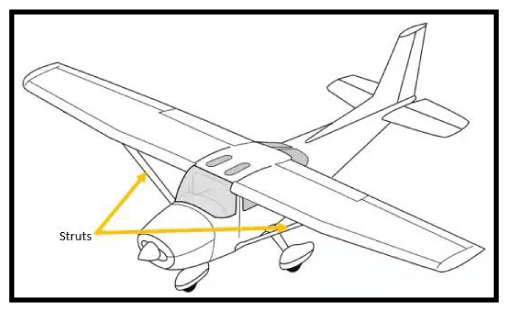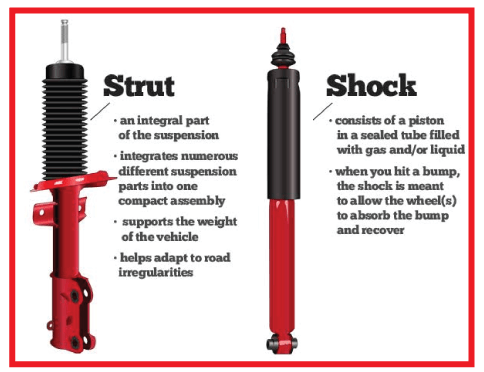Strut MeaningA strut can be defined as a structural element commonly detected in anatomy, architecture, aeronautics, and engineering. Generally, strut work by opposing longitudinal compression, although they serve in tension as well. Human AnatomyA segment of the clavicle functionality is to deliver as the strut among the sternum and scapula, opposing forces that will otherwise take the upper limb near to the thorax. Its motion range must keep the top limb away through the thorax. Complete inadequacy of clavicles might be found in cleidocranial dysostosis or the unnatural shoulders proximity to a median plane represents the importance of the clavicle as the strut. Construction and ArchitectureStrut is a general term in timber framing for scantling's brace or supports lighter than a post. Struts are frequently detected in the roof framing through either a king post or tie bean to a principal timber. Vertically, the strut may be leaning or plumb (then known as angled, raking, or canted) and may be curved or straight. A few key points are discussed as follows:
Aircraft
Bracing wires and struts of several types were broadly used in the previous aircraft to strengthen and stiffen (sometimes to form) the primary functional airframe. They fell out of the usage in the construction of the low-drag cantilever during the 1920s and 1930s. Most of the aircraft bracing struts are loaded within compression along with wires keeping the tension loads. Various lift struts have increased their use and remain their use over smaller aircraft where eventual performance is not a problem. They are generally used to the high-wing monoplane and performing in the tension in flight. The strut has been mostly used for completely structural reasons for attaching landing gear, engines, and other types of loads. Still, the oil-sprung legs of retractable landing gear are known as Oleo struts. AutomobilesStruts could be passive braces for reinforcing the body or/and chassis or active suspension components as the components of the automobile chassis. An example of the active unit will be a coil-over design within the automotive suspension. This coil-over consists of a spring and shock absorber in one unit. Some of the key points are as follows:
Shipping-related struts can be used within load-bearing functions ranging from off-loading and highway suspensions to hatch window and automobile hood that supports many aircraft wing supports. The bulk of struts offer a bearing, though for the conditions if the strut mounts implement as the steering pivots. The bearing is a wear item for such types of struts because it is subjected to a case of constant vibration impact. Its status reflects both steering response and wheel alignment. Most commonly, struts are the assembly of shock absorbers and coil-over springs in a vehicle suspension system. Other variants for using the coil-over spring same as the load bearer add support by pressurizing nitrogen gas behaving like a spring or hardtail (rigid) support. It facilitates neither longitudinal damping nor extension/compression. History of StrutsIn the 1970s, the strut was developed where automakers transitioned through wide rear-wheeled vehicles to front-wheeled fuel-efficient vehicles. The whole suspension system was modified according to match the new technique of vehicles. They left limited room for a traditional system that was known as long arm/short arm suspension systems. It leads to the MacPherson strut system becoming the newer standard for every automobile including rear-wheeled and front-wheeled vehicles. The MacPherson strut systems don't need a top control arm, pivot shaft, or bushings like earlier models. Vehicle OptionsThis single strut pair is almost the MacPherson strut. These selections are created for several reasons such as the balance of performance, initial cost, and other components. A few vehicles apply the double-wishbone where, where exclusively suspension system uses the shock absorbers. Various sports cars imply to favor this type of suspension style. But, the Porsche 911 implies classic struts. MaintenanceStruts manage our suspension aligned with a lot of other functions. For checking a strut set is failing; walk to all sides of a wheel and start to jump the car down and up simply. Let it jump back into the position as a car is moved down. Consider taking our vehicle to any mechanic for substitution when it continues to jump down and up.
Struts vs. Shocks
It is a basic question that we get as the terms strut and shock are used interchangeably. A strut and shock do a similar common job over a vehicle. They are damping the actions of spring and ending bounce and oscillation. They do even though similar things, but struts and shocks are different parts completely. A strut can't be used for replacing a shock and a shock can't be used for replacing a strut. The vehicles will contain either a strut or a shock at all the wheels, never both. All the vehicles were created with either struts or shocks and our suspension of the vehicle can't be modified to apply the other.
Next TopicObligation Meaning
|
 For Videos Join Our Youtube Channel: Join Now
For Videos Join Our Youtube Channel: Join Now
Feedback
- Send your Feedback to [email protected]
Help Others, Please Share










